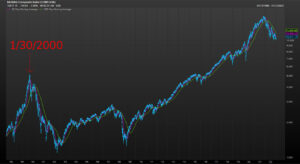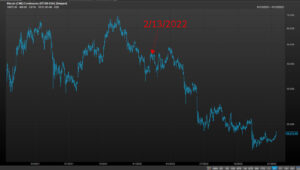“Sometimes when you think something is shiny and gold, it tends to be rusted and bronze, but that’s just the way it is, man.” -Henry Cejudo (mixed-martial artist)
Now that crypto markets find themselves on the other side of the avalanche that was 2021 and 2022, I’ve heard it commonly referenced as being just like the dot-com bubble and bust. Today we’ll dive deeper into that notion to try and make sense of whether it’s a good or bad analogy. Here we go!
The dot-com bubble
During my fourth year at Penn State Main Campus (fall of 2001), we lived at 228 South Atherton St. – a total dump of a house into which we crammed eight roommates and had a blast. That house was next to the volleyball house (which was next to the local fire station at the intersection of Atherton St. and Beaver Ave, for those familiar with the area). Unsurprisingly, the average height of the volleyball house occupants was about 6’6”, but one very short dude lived there with them as well. His name was Juice. Between his short stature and the fact he drove a super-cool electric blue Audi S4, Juice really stood out from the group.
Juice’s car was completely unattainable for 99.9% of students in State College, so naturally, we were curious about how he got it. And the word on the street was, “his parents hit it big in the dot-com stocks.” I don’t know if they were traders, owned a company, or how much of the story was even true. But that’s all I knew of the dot-com bubble, as it passed me by in real-time during my college years: it resulted in Juice having a car we could only drive in our dreams. In my defense, I had more important things to focus on, namely the college experience. Also, the media was far more avoidable in the era before smartphones.
Once I shifted careers from engineering to financial planning in 2006, it immediately became clear how significant of an event the dot-com bubble/bust and the date “March of 2000” (the Nasdaq peaked at 5132.52 on March 10, 2000) were. Investors were scarred, many lessons were learned, and historical performance charts were forever changed by those events. It wasn’t only the evaporation of companies like Pets.com but also severe drawdowns in companies that would continue to dominate tech for decades. And speaking of Pets.com, I’ve heard it cited in the media in recent weeks as a comparison to the crypto fallout, which prompted me to explore this topic in more detail. I know it’s a fun metaphor, but is it actually a good one?
Super bull
Super Bowl XXXIV (Jan 30th, 2000) featured the then St. Louis Rams and Tennessee Titans at the Georgia Dome (RIP) in Atlanta. More importantly, though, it’s referred to as the “Dot-Com Super Bowl” because about 20 percent of the commercials were for dot-com ads, even though no one seemed to know what they were talking about at the time (or at least I didn’t). Typically, we regard media overhype as a pretty good contrarian indicator. So – given we’re currently getting deeper into the NFL playoff season – I thought it would be fun to see where Super Bowl XXXIV falls on the historical NASDAQ timeline. As shown in the below chart, those dot-com commercials almost perfectly called the top of the NASDAQ and the start of the ensuing tech bust.

*FactSet, Jan. 20, 2023
Football fans may also recall the crypto-hype commercials during last year’s Super Bowl, played between the now Los Angeles Rams and Cincinnati Bengals on Feb 13th, 2022. At least one of those ads involved Matt Damon touting that “fortune favors the brave.” Well, he left out the part about putting a pin in that bravery for at least a year, as crypto has fallen substantially from that point (using Bitcoin as a proxy in the below chart). My guess is that we’ll see far less aggressive crypto commercials during the upcoming 2023 Super Bowl (or maybe none at all), but those would be far better timed than they were last year, as Bitcoin is now about 60% cheaper. It wasn’t quite the prognostication of the dot-com ads back in 2000, but it still would have been a great time to bail on crypto for a while.
*FactSet, Jan. 20, 2023
What really rhymes
The Super Bowl comparison is fun to draw some social context and sentiment comparisons between the dot-coms and crypto. Let’s also look at some additional background on these two bubble-and-bust situations.
Easy money (aka leverage) found within a lower-interest-rate environment coincided with the run-up and overvaluation of both the tech-boom and crypto assets – and the Fed’s raising of interest rates coincided with the demise of both, as well. The monetary environment was a significant contributor to these boom-bust cycles, while tech stocks, cryptocurrencies, and, ultimately, Super Bowl ads were the means of expressing the resulting excess.
When the mood turns, it turns quickly. As this article points out, a Japanese recession also evolved into global recessionary fears, exacerbating the dot-com selloff. And, thinking back to late 2021, when the latest crypto (and tech) selloff got underway, the “r-word” was again on people’s minds as they anticipated years of easy money would soon disappear.
Business matters
Here’s where we can start to add some nuance to the dot-com/crypto analogy. “Pets.com” is probably a fair comparison for crypto/blockchain companies failing to deliver on their business model, generating adequate revenue, and going bankrupt. Both were overhyped, traded at nonsensically astronomical prices, and then crashed to zero. Poof! Just like Pets.com, those weren’t real businesses in the first place. The same is true of fake or fraudulent cryptocurrencies, where mainstream investors probably had more exposure.
But I think it’s important to delineate between bad and good cryptocurrencies, just as it is regarding businesses. Cryptocurrencies with significant use cases and robust frameworks that are insulated from manipulation should be able to weather storms and provide real value to society, as some of their shortcomings (e.g., transaction volume) are continually addressed. It’s also worth mentioning that businesses and crypto are very different. Using Bitcoin as an example, it’s certainly not a business; it doesn’t have a balance sheet and cannot go bankrupt. Bitcoin investors can undoubtedly get into trouble with levering their personal balance sheets, but that’s their problem – not Bitcoin’s.
What’s more interesting to consider is what “crypto” companies may thrive for decades, as technology increasingly relies on blockchain as its backbone. Who will be the winners coming out of this game of “Crypto Survivor” that is currently unfolding? Will mainstream cryptocurrencies, like Ethereum and Bitcoin, gain additional trust and flourish because of their ability to survive this period of chaos? No one knows, but – like those emerging from the dot-com bust – there are many opportunities. Rather than solely focusing on Pets.com as an analogy for crypto, it’s also essential to consider the incredible success stories that followed the dot-com bubble: the universal prevalence of the internet and the development of the world’s leading companies. Thus, “Pets.com” is an okay analogy for part of the crypto story unfolding before us, but it may be missing the forest for the trees. More broadly, however, it does seem like the crypto story has been very similar to the dot-com era.
This ongoing volatility will eventually reward the companies with the right business models and the most robust and regulated crypto exchanges, while fraud and excess leverage continues to be exposed. This cleanup process is a good thing and should reign in the insanity for a while…at least until the next bubble emerges that I’ll get to compare to dot-coms and crypto 20 years from now. I’m looking forward to some ridiculous Super Bowl ads coming our way around 2040, and THEN we’ll know it’s a good time to sell the investment du jour.
Until next time, this is the end of alt.Blend.
Thanks for reading,
Steve



